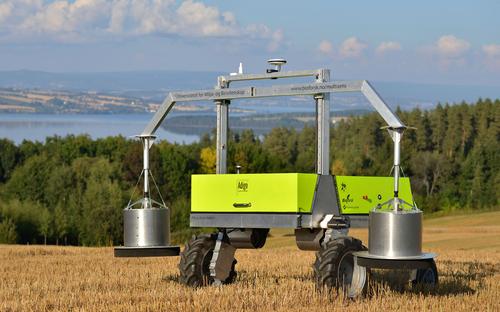Robots, including aerial drones, are revolutionizing agriculture in the greenhouse, the nursery and especially in the open fields where most of the food in the world is grown, according to Frank Tobe, author of The Robot Report.
“Farmers, ranchers and growers the world over are transitioning to precision agricultural methods,” Tobe told EE Times in advance of his exclusive report on agricultural robots, “Subdividing their acreage into many unique subplots—and in some cases right down to the individual plant, tree or animal—thereby enabling increased productivity, traceability and lower overall costs. Unmanned aerial vehicles are integral to the process and are being used to map, observe, sense and spray.”
Here we review the unmanned vehicles, automated machinery and software enabling these new farming methods to farmers worldwide. View this potpourri of images as a slideshow, each image representing a whole family of robotic farming implements and methods.

(Source: Adigo, URL: http://www.adigo.no/portfolio/field-flux-robot-2/)
“Digitally controlled farm implements are already in use in developed countries and most Western farmers and ranchers are already high-tech to some extent,” Tobe told us. “Farmers use software systems and aerial or satellite survey maps and data to guide their field operations and are transitioning from satellite and small-plane photos to those provided by drones with sophisticated sensors. Farmers are also using optional auto-steer kits in most new tractors that follow RTK/GPS and digital guidance.”
Video, above: Leveraging ITS core AutoDrive and eDrive technologies, Autonomous Tractor Corp. (ATC) is developing a whole new generation of tools called the Spirit which aims to half the cost of a traditional tractors while multi-tasking with implements on the front, middle and back, such as mowing, drying and baling hay in one pass. (Source: ATC)
Video: Digital Harvest has adapted the Yamaha RMAX unmanned helicopter from spraying ricer fields to spraying cherry orchards in Washington state.
“Bringing robotic automation to an already automated industry is a slow process, further complicated by the inability of present-day robots to economically and speedily do the particularly critical tasks of harvesting and variable spraying,” Tobe told us. “Consequently, incremental movement from conventional to precision agricultural processes and from precision to robot-assisted still has many challenges that need an R&D solution. Perception, safety and flexibility are paramount and almost economically and mechanically feasible, but not just yet. Consequently, mass harvesting of fruits and vegetables by robots won’t be happening in the next few years.”
The need is there, though, and the return-on-investment (ROI) is there, with an increasingly number of investors footing the bill. And with the price of groceries rising globally, the profits to be made are attracting dozens of new startups with “better ideas” about how to use robots in farming. To meet the needs of a growing worldwide population, look for the increasing use of robots in all aspects of agriculture.
Link: https://youtu.be/ijAfvd6S6-A
Video: The robovator is a vision-based hoeing machine for controlling weeds in row crops illustrated in action here.
(Source: F. Poulsen Engineering APS)
Link: https://youtu.be/eBY26-ZR-gg
Video: Rowbots work in teams to apply fertilizer in synchronization with crop needs, inter-seed cover-crops, and to collect data to inform farmers about both current and needed future work. (Source: RowBot)
“Many factors are precipitating these changes in addition to global population growth and the cost and availability of labor: the diminishing availability and increasing cost of water; political and regulatory procedures (and hold-ups); limited tillable acreage; better, cheaper and faster technological automation products; and climate change, to name just a few,” said Tobe.
Source: EEtimes









